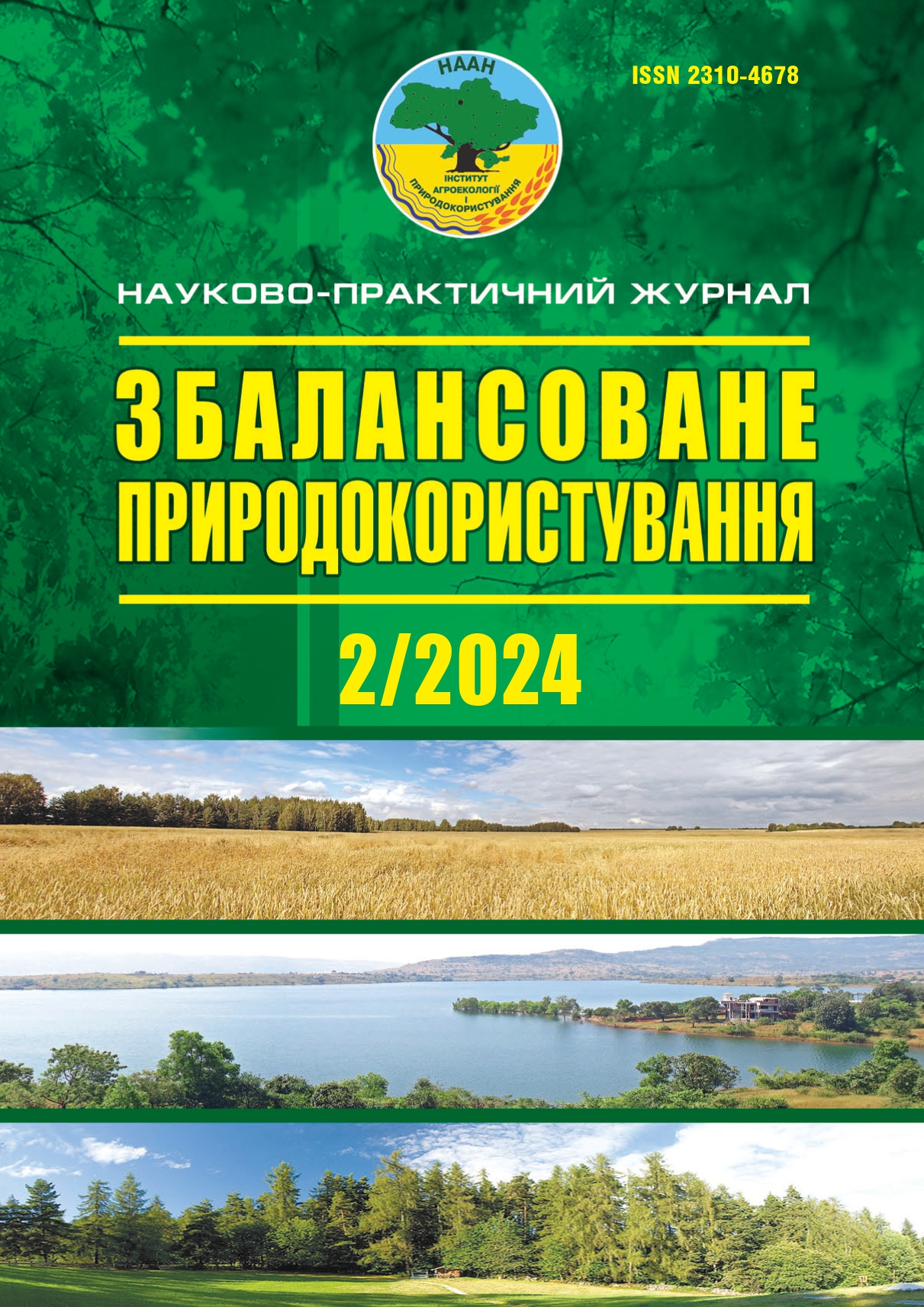ЛІСІВНИЧО-ТАКСАЦІЙНА ХАРАКТЕРИСТИКА ДУБОВИХ ДЕРЕВОСТАНІВ У РЕКРЕАЦІЙНО-ОЗДОРОВЧИХ ЛІСАХ ЛІВОБЕРЕЖНОГО СТЕПУ
DOI:
https://doi.org/10.33730/2310-4678.2.2024.309925Ключові слова:
категорія лісів, походження насадження, таксаційні показники, тип лісу, модальні насадження, високопродуктивні насадженняАнотація
Дослідження лісівничо-таксаційних показників дубових деревостанів у рекреаційно-оздоровчих лісах Лівобережного Степу проведено за матеріалами лісовпорядкування. Проаналізовано розподіл дубових деревостанів у рекреаційно-оздоровчих лісах регіону за місцем розташування, походженням, типами лісу, групами і класами віку, класами бонітету та відносними повнотами. Розраховано показники використання лісорослинного потенціалу модальними дубняками в межах лісових ділянок зелених зон навколо населених пунктів (лісогосподарська частина лісів зелених зон). З’ясовано, що дубові деревостани в рекреаційно-оздоровчих лісах Лівобережного Степу займають площу понад 73 тис. га, або 39% від загальної площі рекреаційно-оздоровчих лісів Лівобережної України. Серед них переважають штучні дубові насадження, частка площі яких становить 52,9%. Порослеві дубові деревостани займають площу 42,5%, а насіннєві природні — 4,6%. Найбільшим запасом (195 м3·га–1) характеризуються насіннєві природні деревостани. Переважають деревостани сухої берестово-пакленової діброви — 25,9 тис. га, що становить 35,4% від загальної площі дубових лісів у регіоні дослідження. За площею та запасом превалюють середньовікові насадження, частка яких становить 60,7% від загальної площі та 56,6% від загального їх запасу. Відмічено переважання за площею дубових деревостанів, які ростуть за II і III класами бонітету (62,7%) та характеризуються відносною повнотою 0,7–0,8 (63,7%). Встановлено, що відносна повнота дубових деревостанів, починаючи із VII класу віку, поступово знижується. Показник використання лісорослинного потенціалу дубняками в межах лісів зелених зон навколо населених пунктів (лісогосподарська частина) порівняно з місцевими високопродуктивними деревостанами становить 76%. Втрати деревини внаслідок недовикористання родючості земель оцінено в 916,7 тис. м3.
Посилання
Hensiruk, S.A., Shevchenko, S.V., Bondar, V.S et al. (1981). Kompleksne lisohospodarske raionuvannia Ukrainy ta Moldovy [Integrated forestry zoning of Ukraine and Moldova]. Kyiv: Naukova dumka [in Ukrainian].
Musiienko, S.I., Lukianets, V.A., Bondarenko, V.V., Rumiantsev, M.H., Kobets, O.V. (2020). Typolohichne riznomanittia rekreatsiino-ozdorovchykh lisiv Livoberezhnoi Ukrainy [Typological diversity of recreational and health-improving forests in Left-Bank Ukraine]. Naukovyi visnyk NLTU Ukrainy — Scientific Bulletin of UNFU, 30 (5), 31–35. DOI: https://doi.org/10.36930/40300505 [in Ukrainian].
Musiienko, S.I., Tarnopilska, O.M., Bondarenko, V.V., Lukianets, V.A., Kobets, O.V., Kostiashkina, T.D. (2022). Landshaftno-rekreatsiina otsinka rekreatsiino-ozdorovchykh lisiv Livoberezhnoi Ukrainy [Landscape and recreation evaluation of recreation and health-improving forests in the Left-Bank Ukraine]. Lisivnytstvo i ahrolisomelioratsiia — Forestry and Forest Melioration, 141, 13–22. DOI: https://doi.org/10.33220/1026-3365.141.2022.13 [in Ukrainian].
Pavlovska, T.S., Biletskyi, Yu.V., Rudyk, O.V., Samoliuk, I.V. (2019). Rekreatsiino-ozdorovchi lisy DP "Liubomlske LH" [Recreational and health improving forests of the SE “Liuboml FE”]. Heohrafiia i turyzm — Geography and tourism, 47, 137–148 [in Ukrainian].
Parpan, T.V., Holubchak, O.I., Hudyma, V.M., Prykhodko, N.F., Falko R.I., Kyrylenko, Ya.O. (2021). Kharakterystyka rekreatsiino-ozdorovchykh lisiv Ivano-Frankivshchyny ta otsiniuvannia yikh potentsialu na postiinykh doslidnykh obiektakh. [Characteristics of recreation forests of Ivano-Frankivsk region and assessment of their potential at permanent research sites]. Naukovyi visnyk NLTU Ukrainy — Scientific Bulletin of UNFU, 31 (5), 9–16. DOI: https://doi.org/10.36930/40310501 [in Ukrainian].
Pro zatverdzhennia poriadku podilu lisiv na katehorii ta vydilennia osoblyvo zakhysnykh lisovykh dilianok: Postanova Kabinetu ministriv Ukrainy vid 16 kvitnia 2007 roku № 733 [On approval of the Procedure for division of forests into categories and allocation of specially protected forest areas: Resolution of the Cabinet of Ministers as of May 16, 2007, N 733. (2007). URL: https://zakon.rada.gov.ua/laws/show/733-2007-%D0%BF# Text [in Ukrainian].
Prykhodko, N.F., Parpan, T.V., Holubchak, O.I., Prykhodko, M.M., Hudyma, V.M. (2022). Radialni pryrosty derevostaniv rekreatsiino-ozdorovchykh lisiv Prydnistrovskoho Peredkarpattia (Ivano-Frankivska oblast). [Radial growth of forest stands of recreational and health-improving forests of Prydnistrovya Subcarpathian region (Ivano-Frankivsk region)]. Naukovyi visnyk NLTU Ukrainy — Scientific Bulletin of UNFU, 32 (5), 42–49. DOI: https://doi.org/10.36930/40320506 [in Ukrainian].
Tkach, V.P., Kobets, O.V., Rumiantsev, M.H. (2018). Vykorystannia lisoroslynnoho potentsialu lisamy Ukrainy [Use of forest site capacity by forests of Ukraine]. Lisivnytstvo i ahrolisomelioratsiia — Forestry and Forest Melioration, 132, 3–12. DOI: https://doi.org/10.33220/1026-3365.132.2018.3 [in Ukrainian].
Bondar, O., & Tsytsiura, N. (2021). Recreational and health forests of Kremenets district, Ternopil region. Balanced nature management, 2, 80–87. DOI: https://doi.org/10.33730/2310-4678.2.2021.237994 [in English].
Gerstenberg, T., Baumeister, C.F., Schraml, U., & Plieninger, T. (2020). Hot routes in urban forests: The impact of multiple landscape features on recreational use intensity. Landscape and Urban Planning, 203, 103888. DOI: https://doi.org/10.1016/j.landurbplan.2020.103888 [in English].
Getzner, M., & Meyerhoff, J. (2020) The benets of local forest recreation in Austria and its dependence on naturalness and quietude. Forest, 11 (3), 326. DOI: https:// doi.org/10.3390/f11030326 [in English].
Jean, R., Naka, K., Christian, C.S., Gyawali, B.R., Bowman, T., Hopkinson, S. (2022). Identifying primary drivers of participants from various socioeconomic backgrounds to choose national forest lands in the Southeastern Region of the US as a Travel Destination for Recreation. Land, 11 (8), 1301. DOI: https://doi.org/10.3390/land11081301 [in English].
Pintilii, R.-D. (2022). Forest Recreation and Landscape Protection. Forests. 13 (9), 1440. DOI: https:// doi.org/10.3390/f13091440 [in English].
Sanchez-Badini, O., & Innes, J.L. (2019). Forests and trees: A public health perspective. Sante publique (Vandoeuvre-les-Nancy, France), S1 (HS), 241–248. DOI: https://doi.org/10.3917/spub.190.0241 [in English].
Siruk, I., & Siruk, Yu. (2023). Recreation characteristics of the green zone forests of the Zhytomyr city. Ukrainian Journal of Forest and Wood Science, 14 (4), 73–87. DOI: 10.31548/forest/4.2023.73 [in English].
Siruk, I., & Siruk, Yu. (2020). Structure of forest sites of the green belt of Zhytomyr city. Scientific Horizons, 23 (12), 18–28. DOI: 10.48077/scihor.23(12).2020.18-28 [in English].
##submission.downloads##
Опубліковано
Номер
Розділ
Ліцензія
- Автори залишають за собою право на авторство своєї роботи та передають журналу право першої публікації цієї роботи на умовах ліцензії Creative Commons Attribution License, котра дозволяє іншим особам вільно розповсюджувати опубліковану роботу з обов'язковим посиланням на авторів оригінальної роботи та першу публікацію роботи у цьому журналі.
- Автори мають право укладати самостійні додаткові угоди щодо неексклюзивного розповсюдження роботи у тому вигляді, в якому вона була опублікована цим журналом (наприклад, розміщувати роботу в електронному сховищі установи або публікувати у складі монографії), за умови збереження посилання на першу публікацію роботи у цьому журналі.
- Політика журналу дозволяє і заохочує розміщення авторами в мережі Інтернет (наприклад, у сховищах установ або на особистих веб-сайтах) рукопису роботи, як до подання цього рукопису до редакції, так і під час його редакційного опрацювання, оскільки це сприяє виникненню продуктивної наукової дискусії та позитивно позначається на оперативності та динаміці цитування опублікованої роботи (див. The Effect of Open Access).


